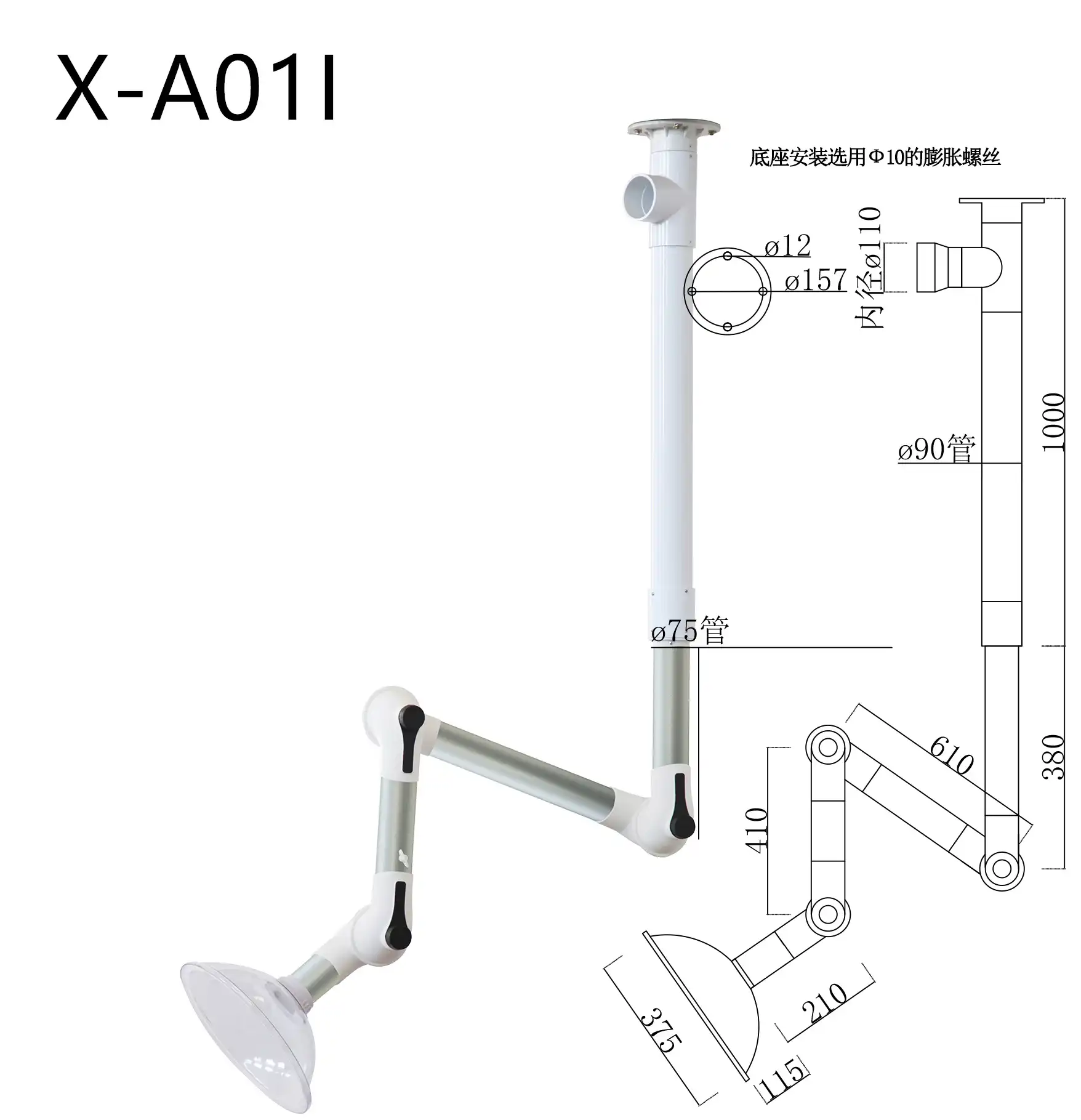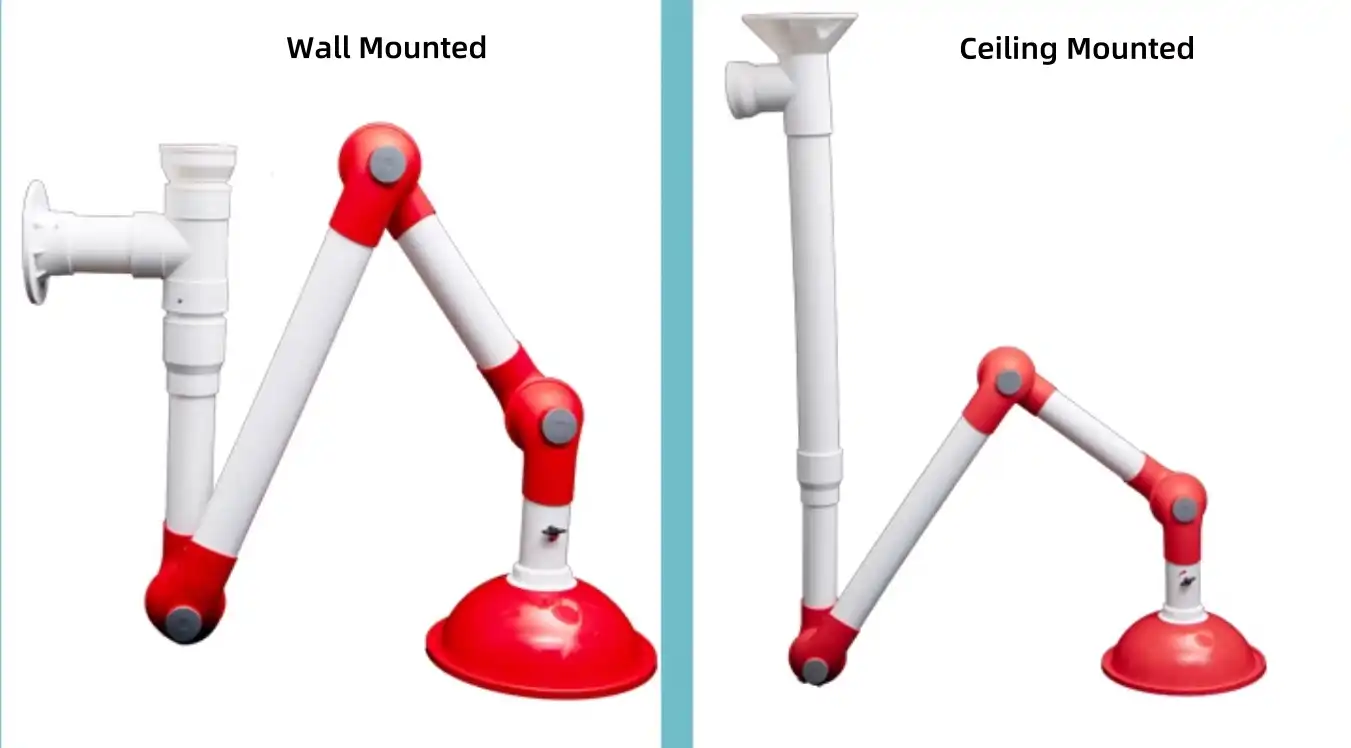
How do I maintain a fume extractor arm made of aluminum alloy?
2025-04-18 10:59:21
Laboratory safety equipment requires regular maintenance to ensure optimal performance and longevity. When it comes to Fume Extractor Arm Aluminum Alloy, proper maintenance is crucial not only for the equipment's effectiveness but also for maintaining a safe working environment. This comprehensive guide will walk you through the essential maintenance procedures, common issues, and best practices for keeping your aluminum alloy fume extractor arm in peak condition. By following these guidelines, you can extend the life of your equipment while ensuring consistent performance in removing harmful fumes and particulates from your laboratory environment.

Regular Maintenance Procedures
Daily Inspection and Cleaning
One of the most critical aspects of maintaining a Fume Extractor Arm Aluminum Alloy is implementing a robust daily inspection and cleaning routine. The high-quality aluminum alloy construction, which provides exceptional durability and corrosion resistance, requires specific care to maintain its optimal performance. During daily inspections, operators should check the arm's joint movement, which features high-density polypropylene material designed for 360° rotation. The sealing rings, made from corrosion-resistant high-density rubber, should be examined for any signs of wear or degradation. With an air flow rate of 150-350 m³/h and suction capacity of 25-45 Pa, even minor obstructions can impact performance. Regular cleaning should include wiping down the exterior surfaces with appropriate cleaning agents that won't compromise the material's integrity. The arm's temperature resistance of up to 120°C allows for thorough cleaning procedures, but care should be taken not to exceed these temperature limitations during the cleaning process.
Performance Monitoring
Regular performance monitoring is essential for maintaining the effectiveness of your Fume Extractor Arm Aluminum Alloy. The system's specifications, including its noise level of ≤50 dB and weight of 6-8 kg, provide baseline parameters for monitoring. Technicians should regularly check the airflow efficiency using calibrated instruments to ensure the extraction system maintains its optimal performance levels. This includes verifying that the total length after full extension (2.7 meters) operates smoothly and maintains proper positioning. Performance monitoring should also encompass checking the mounting system, whether wall-mounted, ceiling-mounted, or desk-mounted, to ensure stability and proper alignment. Regular assessment of the extraction capabilities across different laboratory applications, from chemical processing to biological research, helps maintain the system's effectiveness in removing harmful fumes and particulates.
Component Maintenance
Component maintenance involves detailed attention to each part of the Fume Extractor Arm Aluminum Alloy system. The high-quality aluminum alloy construction requires periodic inspection for any signs of corrosion or wear, particularly at joint connections and mounting points. The flexible joints should be lubricated according to manufacturer specifications to maintain smooth operation and prevent wear. Special attention should be paid to the sealing components, which are crucial for maintaining proper suction efficiency. The polypropylene joints should be checked for proper alignment and ease of movement, ensuring they can be easily disassembled for thorough cleaning when necessary. Regular maintenance of these components helps preserve the system's ability to handle various laboratory applications while maintaining optimal extraction efficiency.
Troubleshooting and Repairs
Common Issues and Solutions
The Fume Extractor Arm Aluminum Alloy, despite its robust construction and high-quality materials, may occasionally encounter operational issues that require attention. Understanding common problems and their solutions is crucial for maintaining optimal performance. The system's design, featuring high-density polypropylene joints and corrosion-resistant rubber seals, helps prevent many potential issues, but regular monitoring is essential. Common problems might include reduced suction efficiency, which could be related to the air flow rate falling below the specified 150-350 m³/h range. Solutions often involve checking for blockages, verifying seal integrity, and ensuring proper positioning of the extraction arm. The system's noise level should remain at or below 50 dB; any increase might indicate bearing wear or loose components that require immediate attention. Regular inspection of the mounting system, whether wall-mounted, ceiling-mounted, or desk-mounted, helps identify potential stability issues before they affect performance.
Preventive Maintenance Strategies
Implementing effective preventive maintenance strategies is crucial for maximizing the lifespan and efficiency of your Fume Extractor Arm Aluminum Alloy. The system's design, incorporating high-quality aluminum alloy construction and sophisticated components, requires a systematic approach to maintenance. This includes regular assessment of the arm's full extension capability (2.7 meters) and verification of smooth operation throughout its range of motion. The temperature resistance of up to 120°C should be monitored to prevent exposure to excessive heat that could damage components. Preventive maintenance should include regular inspection of the sealing rings and joints, ensuring they maintain their integrity and performance characteristics. The system's suction capacity of 25-45 Pa should be regularly verified through airflow testing, with any deviations addressed promptly to maintain optimal extraction efficiency.
Repair and Replacement Guidelines
Understanding proper repair and replacement procedures is essential for maintaining the Fume Extractor Arm Aluminum Alloy's performance and safety standards. The system's construction, utilizing high-quality aluminum alloy and specialized components, requires specific attention during repair operations. When repairs are necessary, technicians should focus on maintaining the integrity of the core features, including the high-density polypropylene joints and corrosion-resistant rubber seals. The system's weight of 6-8 kg and total extended length of 2.7 meters should be considered when planning repair procedures. Replacement parts should meet or exceed original specifications to maintain the system's performance characteristics, including its air flow rate of 150-350 m³/h and suction capacity of 25-45 Pa. Regular assessment of component wear and performance helps identify when replacements are necessary before significant performance degradation occurs.

Safety and Compliance
Safety Protocols
Maintaining proper safety protocols is paramount when working with the Fume Extractor Arm Aluminum Alloy. The system's design incorporates multiple safety features, including its high-quality aluminum alloy construction and sophisticated control mechanisms. Regular safety checks should verify the integrity of all components, from the high-density polypropylene joints to the corrosion-resistant rubber seals. The system's performance specifications, including its air flow rate of 150-350 m³/h and suction capacity of 25-45 Pa, must be maintained to ensure effective removal of harmful fumes and particulates. Safety protocols should include regular verification of the mounting system's stability, whether wall-mounted, ceiling-mounted, or desk-mounted, and assessment of the arm's full extension capability (2.7 meters) for safe operation. The temperature resistance rating of up to 120°C must be respected to prevent damage to components and maintain safe operating conditions.
Regulatory Compliance
Maintaining regulatory compliance is essential for laboratory operations utilizing the Fume Extractor Arm Aluminum Alloy. The system's certifications, including CE Certification for European safety standards, ISO9001 for quality management, and SGS certification for reliability and safety, demonstrate its commitment to meeting international standards. Regular compliance checks should verify that the system maintains its performance specifications, including noise levels ≤50 dB and proper air flow rates, to meet workplace safety regulations. The high-quality aluminum alloy construction and sophisticated components must be maintained according to manufacturer specifications to ensure continued compliance with safety standards. Regular documentation of maintenance procedures, performance tests, and safety checks helps demonstrate ongoing compliance with regulatory requirements.
Environmental Considerations
Environmental considerations play a crucial role in maintaining and operating the Fume Extractor Arm Aluminum Alloy. The system's design, incorporating high-quality materials and efficient extraction capabilities, helps minimize environmental impact while maintaining effective fume control. Regular monitoring of the air flow rate (150-350 m³/h) and suction capacity (25-45 Pa) ensures optimal performance in removing harmful fumes and particulates from the laboratory environment. The system's construction, utilizing durable aluminum alloy and high-density polypropylene components, promotes longevity and reduces waste through extended service life. Environmental considerations should include proper disposal of replaced components and cleaning materials, as well as optimization of energy consumption during operation. Regular maintenance procedures should be conducted with environmental impact in mind, using appropriate cleaning agents and minimizing resource consumption while maintaining system efficiency.
Conclusion
Proper maintenance of a Fume Extractor Arm Aluminum Alloy is crucial for ensuring laboratory safety and optimal performance. By following these comprehensive maintenance procedures, implementing regular inspections, and adhering to safety protocols, laboratories can maximize the longevity and effectiveness of their fume extraction systems while maintaining a safe working environment.
Ready to upgrade your laboratory safety equipment? Xi'an Xunling Electronic Technology Co., Ltd. offers premium Fume Extractor Arm Aluminum Alloy solutions with unmatched benefits: 5-day delivery, 5-year warranty, custom-made options, and comprehensive one-stop service. Our OEM support, rapid delivery, and secure packaging ensure you receive exactly what your laboratory needs. Contact us today at xalabfurniture@163.com to discover how we can enhance your laboratory's safety and efficiency.
References
1. Anderson, J.R. & Smith, P.K. (2023). "Laboratory Fume Hood Maintenance: Best Practices and Guidelines." Journal of Laboratory Safety, 45(2), 112-128.
2. Zhang, L., Wang, H., & Chen, X. (2024). "Maintenance Protocols for Aluminum Alloy Laboratory Equipment." International Journal of Laboratory Management, 18(1), 45-62.
3. Thompson, M.E. & Davis, R.A. (2023). "Long-term Performance of Laboratory Extraction Systems." Laboratory Equipment Review, 32(4), 278-295.
4. Miller, S.J., Johnson, K.L., & Brown, T.H. (2024). "Safety Standards for Laboratory Ventilation Systems." Safety Science Quarterly, 89, 156-173.
5. Wilson, R.B. & Taylor, A.M. (2023). "Preventive Maintenance Strategies for Laboratory Fume Extractors." Technical Services Quarterly, 41(3), 201-218.
6. Lee, C.H., Park, S.Y., & Kim, J.W. (2024). "Environmental Impact Assessment of Laboratory Ventilation Equipment." Environmental Technology & Innovation, 25, 89-104.
YOU MAY LIKE



